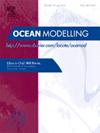Impact of offshore wind farm monopiles on hydrodynamics interacting with wind-driven waves
IF 2.9
3区 地球科学
Q2 METEOROLOGY & ATMOSPHERIC SCIENCES
引用次数: 0
Abstract
This paper investigates the local and regional impact of offshore wind farm (OWF) foundations on hydrodynamics in interaction with wind-induced waves at the Meerwind-OWF site (German Bight, North Sea) on tidal and monthly time scales. For this purpose, a 3D high-resolution coupled circulation-wave model based on unstructured grids is employed, which enables an effective transition in resolution from ∼2 km in marine open boundaries to ∼2 m near the foundations. The OWF monopiles induce different local and regional changes of the monthly mean velocity at mid-depth: a decrease of ∼5 % near the piles and an increase of ∼1 % in a wider region surrounding the OWF. The latter can be attributed to the relevant regional reduction in water density of ∼0.02 %. Consequently, the monthly potential energy anomaly increases by ∼5 % outside the OWF, while it decreases by 40 % inside it. The monopiles reduce the monthly significant wave height (Hs) from ∼5 % within the OWF to <1 % over distances of ∼20 km. The prevailing westerly waves can affect the tidal asymmetry, particularly on the eastern side of the piles. This results in an asymmetry in the intensity of turbulent wakes on either side of the piles, in both monthly and tidal timescales. However, wave intensification can disrupt the periodic tidal pattern of the wake. An extreme event with Hs>4 m creates a peak wake during the slack water that is higher than those at times of maximum tidal currents during spring tides.
海上风电场单桩与风浪相互作用对水动力的影响
本文在潮汐和月时间尺度上研究了Meerwind-OWF站点(北海德国湾)海上风电场(OWF)地基与风致波相互作用对水动力的局部和区域影响。为此,采用了基于非结构化网格的3D高分辨率耦合循环波模型,该模型可以实现从海洋开放边界的~ 2 km到基础附近的~ 2 m的有效分辨率转换。OWF单桩引起中深度月平均速度的不同局部和区域变化:在桩附近减少~ 5%,而在OWF周围更广泛的区域增加~ 1%。后者可归因于相关区域水密度降低了~ 0.02%。因此,月势能异常在OWF外增加了~ 5%,而在OWF内减少了40%。单桩使月有效波高(Hs)在OWF内从~ 5%降低到~ 1%,距离为~ 20km。盛行的西风波浪会影响潮汐的不对称性,特别是在桩的东侧。这导致了在月和潮汐时间尺度上,桩基两侧湍流尾迹强度的不对称。然而,波浪的增强会破坏尾迹的周期性潮汐模式。4米的极端事件在淡水期间产生的峰值尾流高于大潮期间最大潮流时的峰值尾流。
本文章由计算机程序翻译,如有差异,请以英文原文为准。
求助全文
约1分钟内获得全文
求助全文
来源期刊

Ocean Modelling
地学-海洋学
CiteScore
5.50
自引率
9.40%
发文量
86
审稿时长
19.6 weeks
期刊介绍:
The main objective of Ocean Modelling is to provide rapid communication between those interested in ocean modelling, whether through direct observation, or through analytical, numerical or laboratory models, and including interactions between physical and biogeochemical or biological phenomena. Because of the intimate links between ocean and atmosphere, involvement of scientists interested in influences of either medium on the other is welcome. The journal has a wide scope and includes ocean-atmosphere interaction in various forms as well as pure ocean results. In addition to primary peer-reviewed papers, the journal provides review papers, preliminary communications, and discussions.
 求助内容:
求助内容: 应助结果提醒方式:
应助结果提醒方式:


